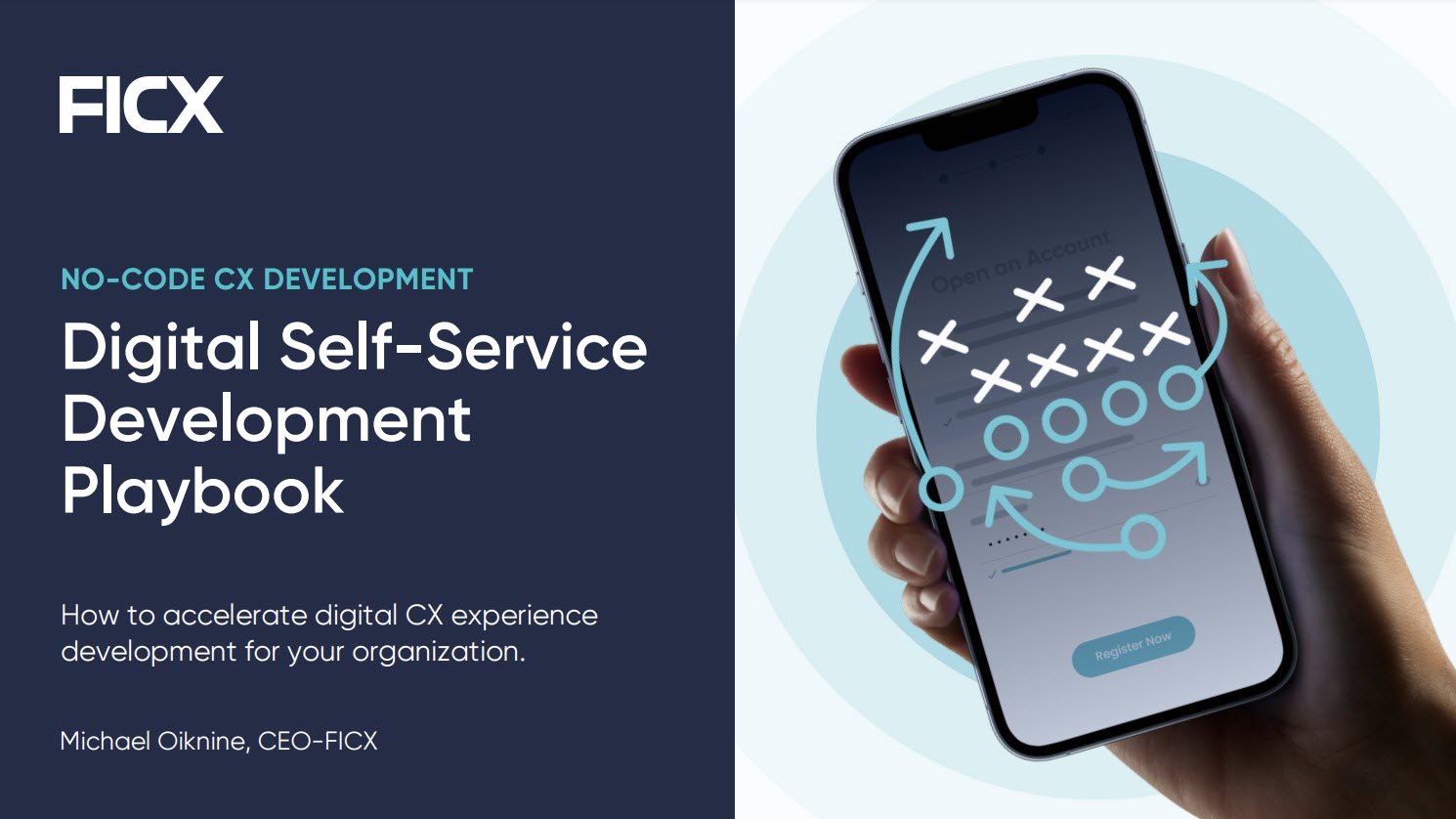Can low-code be the solution you need to dramatically accelerate development cycles of digital self-service experiences? Low-code digital CX platforms are among the most talked-about developments in customer experience. It’s not unusual for something new to be “buzzy” in digital, but what’s interesting about this CX topic is how many companies are actively leveraging this emergent technology to drive digital transformation in their orgs.
Early Mover Verticals
Five verticals encompass many of the early movers in this dynamic space:
No code development platforms are transforming many aspects of software development. By no code digital CX, we mean the ability to develop, integrate, and deploy a customer-facing “last-mile” digital channel experience without knowing code. The promise of no code is that any professional can create a great user experience as part of a digital customer service strategy.
Components of Low-Code Digital CX Platforms
Low-code experiences are usually developed in specially designed, visually-driven platforms in which users can build their experiences with intuitive tools. The best such platforms offer five core sets of capabilities:
Architect an Experience
It’s essential to outline all of the elements of an experience and how it impacts the customer interaction and the organization. With a no code platform, the user defines:
- The customer engagement goals and how they relate to customer satisfaction/customer loyalty
- How the experience is placed in the customer journey
- The critical elements of the experience workflows
- Ways that the experience will integrate with company business process and systems
- The touchpoint(s) where the application will be deployed
Additionally, the most robust toolsets also incorporate real-time analytics to analyze the experience and pinpoint optimization opportunities. In this way, organizations can better meet customer needs and potentially drive greater customer lifetime value.
Build an Experience
This is the most “telegraphic” area of a no code platform because it is how the platform operators create customer-facing elements like forms. A visual interface enables the user to:
- Drag and drop form elements and other features
- Build the steps of the experience
- Incorporate content and capabilities like multimedia, visual IVR, contact center collaboration tools, esign, acknowledgments, etc.
As you evaluate platforms, consider usability here because tools with simple, intuitive user experiences will further accelerate your CX app development.
Integrate with Existing Systems
The way a customer interacts with an experience is the proverbial tip of the iceberg. What the company does with the customer data information is as important as building a pleasant interface. A big part of this is to connect the new last-mile experience with the existing processes and platforms a company uses to conduct business. For example:
- Leverage pre-built or API-based integrations with elements of the company tech stack, e.g., CRM, ERP, marketing automation, IVR, cCaaS, account management, etc.
- Access and utilize pre-existing data to personalize the experience and make it easier/more dynamic
- Exchange form data in real-time across multiple systems, including platforms that are otherwise siloed, for additional personalization
Deliver Across Touchpoints
Customers want to be able to access an experience on their terms. This is a keystone of meeting customer expectations in 2022 and beyond. They want to engage with a process whenever and wherever they want, often across multiple channels. A no code digital experience platform works best when its experiences capability is interoperable, delivering an omnichannel customer experience:
- On websites and portals
- In mobile sites and apps
- In retail locations, branches, and in in-person sales and support meetings
- Via contact center and sales call interactions
That ensures a consistent and intuitive overall customer experience.
Utilize Analytics and Optimization
Once deployed, collecting and interpreting in-market data affords unique opportunities to gauge performance and identify ways to optimize:
- Are more users getting their desired outcomes?
- Has the process speeded AHT and other measures?
- Is customer feedback on the new experience positive?
- Are there still bottlenecks where you are losing customers or sales?
Analytics enable continuous improvement — an essential element of a robust customer experience strategy.
Benefits to CX Leaders
Automation is a top goal for almost every CX team. There are a variety of digital customer experience benefits that come from no code digital experience.
No Demand on Development Teams
Most organizations have fewer developers than they do digital technology projects. Customer experiences are vital to a business but can get lost in the dev queue. Further, creating digital CX experiences requires developers with uncommon skillsets that companies may struggle to attract and retain. For example, mobile developers are in an even shorter supply than other developers, but mobile experience is the dominant method consumers connect to the web.
Importantly, no code doesn’t take away the opportunity to ensure security and other considerations are addressed. I.T. organizations have ample opportunity to evaluate platforms and specific experiences before they go live, whenever necessary. But oversight naturally requires fewer resources than does from-scratch development.
Additionally, purpose-built low-code platforms can consistently deliver privacy by design — which can actually deliver increased security versus custom development. With no code, a company can get its customer-facing experiences built while developers tackle more complex projects and challenges. Given the backlog of tasks for most I.T. and product teams, this is tremendously valuable to most companies.
Shorter Development Timelines
Related to the first benefit, no code apps can almost always be developed much more quickly than custom software. In many instances, no code digital cx platform may have already anticipated everyday use cases and can apply the collective experience of multiple businesses to each project.
Development can be quicker, and because anyone can do the “developing,” there is little or no need to wait for a dev queue for a project to begin.
Lower Development Costs
Developers are expensive, as are long timelines. No code tools consistently deliver an experience at a far lower cost than custom or low code app development.
The cost per experience is lower, but so are the costs of optimization and the costs of quickly addressing new challenges as they arise. From a new integration to exploding popularity for a new social media platform, to new salesforce and marketing needs, to new customer expectations regarding personalized experiences, no code allows doing more with less.
Anticipate and Respond to Changing Customer Behavior
Most of us have witnessed situations where a multimonth or multi-year project finally launches but lags behind competitor innovation or constantly changing customer behavior.
Digital experience is such a dynamic field. Sales teams, customer service departments, marketers, and other company teams need to respond quickly to market adjustments. With low-code, speed and lower costs enable companies to move rapidly and even anticipate future change.
Ability to Test and Optimize Experiences
No code enables customer experience teams to be remarkably agile. Apps can be developed quicker, and real-time performance analytics can identify ways to optimize the experience. Then, the new experience can be revised and redeployed more rapidly. No code can also facilitate more experience testing. Multiple versions of an experience can be deployed simultaneously in head-to-head testing.
Naturally, you can test custom applications against one another as well, but no code makes it faster and easier to version and collect real-time performance insights of a single experience. Imagine, for example, testing:
- Fundamentally distinct experiences
- Processes that vary in the number of screens for a form
- Text and button versions
- Performance in different touchpoints
- Etc.
No Code Digital CX Platforms: Conclusions
The benefits of no code digital CX are numerous and substantial. That’s why so many companies are exploring, testing, and deploying no code digital CX platforms at a brisk clip. It’s a trend — and a technology — that every CXO needs to research and consider.
Consider Callvu
Callvu is helping companies optimize customer experiences by automating processes, clearing bottlenecks, and empowering customer-facing teams to be more productive. By deploying the Callvu Low-Code Digital CX Platform, you can use its powerful workflow and analytics suites to automate and digitize any digital customer interaction without taxing tech resources. From there, you can easily deploy the experiences across multiple channels. That means for all customer touchpoints and digital channels:
The latest digital process automation tools empower you to streamline, automate and remove friction from the customer journey, enhancing customer experience and lowering costs across your organization. The cloud-based or locally deployed Callvu platform digitizes and automates any customer processes and delivers them to your choice of customer touchpoints.
With the Callvu platform tool, business users can deliver customers a consistent, seamless digital experience on the web, in an app, in the contact center, or brick and mortar. Employee and customer feedback on Callvu experiences are universally positive.
Visit our homepage or request a demo nowab




